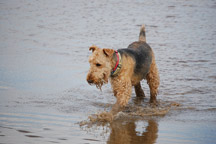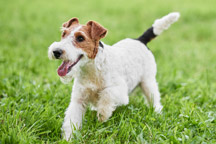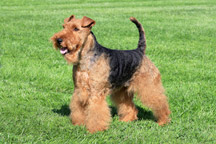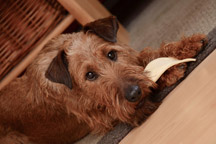Are Lakeland Terriers Hypoallergenic Dogs?
Yes, they are! With a low propensity to drool, and a wiry coat that sheds little — the Lakeland is a superior hypoallergenic doggie!
The Hypoallergenic Lakeland Terrier
Things in life typically come in threes — Musketeers, Men and a Baby, and blind mice.
And, unfortunately, so do the causes of dog allergies — fur, dander, and saliva.
But, with the hypoallergenic Lakeland Terrier — this trio is happily absent! Ok, perhaps not entirely eliminated — but, compared to the majority of pooches, this triumvirate is relatively powerless.
Dogs shed fur — it’s a fact of poochie life. If they didn’t, that hair would never be replaced. Furthermore, all canines have dander — the dead skin cells that dissipate into the air and set you off on a sneezing frenzy.
Not only does the Lakeland terrier shed little hair and skin, what it does — theoretically — is discard remains trapped within its adorable fur.
Here’s the secret.
These pooches have a dense, coarse, and wiry double coat. When Lakeland Terriers drop their old hair and skin, it becomes imprisoned by this ‘net’ of fur. Thus, it’s not discarded onto your sofa, bed, or floors.
And — if it’s not on your furniture or floating around in the air — it’s not going to cause sniffles, coughing, or itching.
Admittedly, you will — from time to time — need to brush your Lakeland to remove these allergy antagonists — and prevent matting — but that’s a small price to pay for an intolerance and symptom-free household.
Furthermore, the Lakeland Terrier isn’t a drooler or a slobberer. This is a massive bonus for sensitive pet parents — the proteins in canine saliva can set off unwanted physiological reactions.
Are Lakeland Terrier Hypoallergenic Dogs? Contents
About the Lakeland Terrier
Characteristics of the Lakeland Terrier
Lakeland Terrier Temperament
Lakeland Terrier Training and Exercise
Lakeland Terrier Health Problems
Conclusion
Lakeland Terrier FAQs
Lakeland Terrier Fact Summary

About the Lakeland Terrier
The Lakeland Terrier hails from England. Specifically, from an area in the northwest of the country known as the Lake District — known for, well, its lakes.
And like all the terriers bred in the UK in the 19th century (when people were completely obsessed by them) — it gained its name from the area in which it was first bred (like the Yorkshire, Norfolk, Airedale, Cairn — you get the idea).
Originally, this pooch had one primary purpose — to hunt foxes.
But, this wasn’t the grand world of men in red jackets riding atop stallions, blowing their horns, drinking port, and being generally upper-class toffs.
Instead, the Lakeland Terrier was owned by down-to-earth farmers — who used the pooch to rid their fields of the feisty foxes that would otherwise make a meal out of their sheep flocks.
Similar Dog Breeds To Lakeland Terrier
The Lakeland was first registered by the Kennel Club in 1921, and 1934 by the AKC (American Kennel Club). In both, it’s listed in the terrier category.
Characteristics of the Lakeland Terrier
The typical Lakeland Terrier size is around 14-15 inches and average weight is around 17 pounds.
It’s something of a canine cliché — but this is truly a large dog in a tiny package.
Zesty and bold, this pooch has a true workmanlike character, with a sturdy and robust build. Typically, they exhibit a remarkably narrow body — which allows them to squeeze into fox dens to root out the ‘vulpine vermin’ (personally, I think foxes are cute — but then I’m not a farmer having my flock massacred by the Ed Gein of the animal world).
For a terrier, the Lakelands possess unusually long legs — allowing them to cover rough terrain effortlessly and rapidly. They constantly appear on high alert — looking for a fox to nab — but, more usually, waiting for you to throw their ball.
The head is comically rectangular, with powerful jaws and V-shaped ears. While the rest of the body has particularly short hair, they do exhibit longer fur — almost a beard on their faces — and often have additional hair on their legs.
Their coat is wiry and coarse — and will require brushing through at least twice weekly. Furthermore, every three months, the fur will need to be hand-stripped — something that’s best done by a professional groomer.
Typical Lakeland Terrier colors include:
- Blue
- Black
- Liver
- Red
- Wheaten
- Grizzle
- Golden tan

Lakeland Terrier Temperament
If you’re after a lap dog or a pooch with a reserved and retiring nature — then look elsewhere!
The Lakeland Terrier is an incredibly confident and bold type — especially around strangers and other animals. It will not shy away from new characters and will happily investigate anything that moves.
Happily, it’s not at all aggressive — unless you’re a fox. Around kids and other pets, it’s playful and content — and loves attention. It will repay any affection tenfold, making the Lakeland an ideal family pooch.
Lakeland Terrier Training and Exercise
Incredibly fast learners, Lakeland Terriers are virtually perfect pupils — until they become distracted.
Their high intelligence means they can become bored quickly — and hence don’t respond very well to continual and repetitive lessons. Little and often is the key to training with this pooch.
If your instructional sessions become a little monotonous, they’re known to develop ‘selective deafness’ — to the point where you may consider your pooch has a hearing issue. Hence, keep the training interesting and varied.
While loving exercise, Lakelands aren’t overly hyper in a home setting — as long as you provide them with sufficient outdoor activity. A quick walk on a short lead will not satisfy these pooches — they need to be able to run. Hence, having an area where you can set the Lakeland off the leash is a must.
At the very minimum, they will require 40 minutes of exercise per day — and ideally a garden or yard in which to amuse themselves — they’re not really suited to apartment life. They do, however, make perfect jogging or cycling companions.
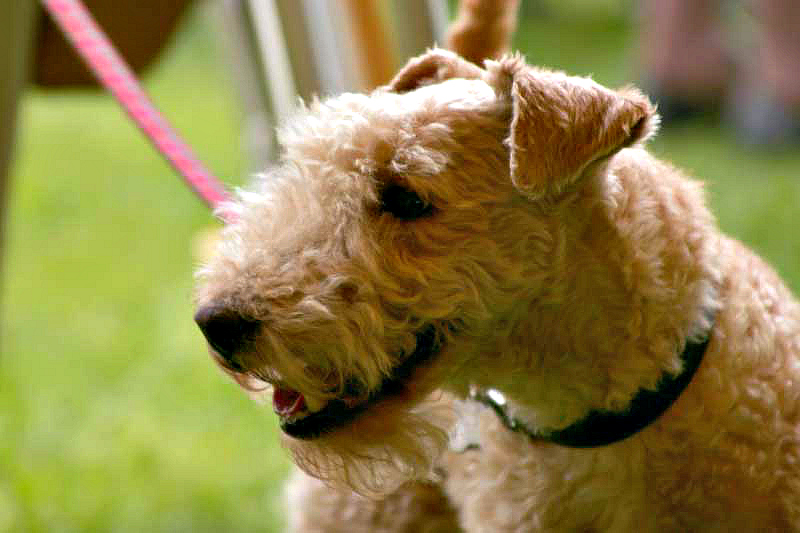
Lakeland Terriers Health Issues
Very few health issues are reported in relation to Lakeland Terriers. Generally speaking, the main concern is their ears.
Being flopped over, and with the Lakeland’s love of exploring undergrowth, burrows, and bushes — they can gather and retain dirt which may lead to infection.
Therefore, it’s essential to keep checking your Lakie’s ears, and clean when necessary — particularly after walking.
Perhaps the only other condition worthy of note is Legg-Calve-Perthes disease. Some Lakelands develop this issue, where blood flow to the doggie’s femur is disrupted, which can lead to the bone becoming brittle. Hence, if you notice any raising of your pup’s hind leg when running or walking, consult with your veterinarian.

Conclusion
The Lakeland Terrier, with his dense and wiry double coat, is perfect for you if you have pet allergies.
Loyal, friendly, and bold, he mixes well with children and other pets — making him an ideal addition to your family.
Just bear in mind, however, that the Lakie loves to exercise! If you don’t have the time or inclination for some brisk walks — or you lack a garden or yard, then it’s best to consider an alternative hypoallergenic dog.
Lakeland Terriers FAQs
Are Lakeland Terriers Good Pets?
Yes. Non-aggressive and wonderful with children and other pets, Lakeland Terriers can be the ideal family dog. Just bear in mind that they do require a considerable amount of exercise.
Are Lakeland Terriers Easy to Train?
Yes. As intelligent dogs, they learn rapidly. However, independent-minded and with a low boredom threshold — they can become easily distracted if training sessions are long and repetitive. Hence, keep the lessons short and interesting for your Lakeland.
Do Lakeland Terriers Shed?
All dogs lose their fur. However, the Lakeland, with its coarse and wiry coat, will retain the majority of any dropped hair — meaning it’s not on your carpets or furniture. This also means they make ideal fur babies for those pet parents with allergies.
Lakeland Terriers Fact Summary
| Breed | Lakeland Terrier |
| Other Names? | Lakie, Lakey, Lake Terrier, Cumberland Terrier, Patterdale Terrier, Fell Terrier, Westmoreland Terrier, and the Colored Working Terrier. |
| Height | 14-15 inches (36 to 38 cm) |
| Weight | 15 to 17 pounds or (6.80 to 7.7 kg) |
| Lifespan | 12 to 15 years |
| Temperament | Bold, loyal, independent, confident, lively, feisty, inquisitive, and friendly. |
| Colors | Blue, black, liver, red, wheaten, grizzle, and golden tan. |
| Coat | Wiry, coarse, and thick double coat. |
| How much grooming? | High maintenance – the coat needs brushing at least twice a week, and a professional should hand-strip. |
| How much shedding | Low |
| Dander levels | Low |
| Saliva – Do they Drool or Lick much? | Low – not a breed prone to slobber or drool. |
| Energy levels | High |
| How much exercise do they need? | Requires at least 40 minutes of brisk walking per day. Makes an ideal running or cycling companion. |
| Health problems | Very few issues. Ensure you check the ears, which are prone to infection. Known to suffer from Legg-Calve-Perthes disease. |
| Good for an apartment? | Not really. They need a yard or garden in which to expend their energy. |
| Suitable for kids? | Great dog for children when socialized and raised together. |
| How much do they bark? | Only when bored or frustrated. |
| Can they be left alone? | Moderate – they don’t like being left alone for long periods. |
| Intelligent? | Highly |
| Trainable? | Yes — but can become bored with long and repetitive sessions. |
| How popular as a pet? | Ranked 147th by the AKC out of 195 breeds. Additionally, the Lakeland Terrier hypoallergenic nature makes them popular with allergy sufferers. |


